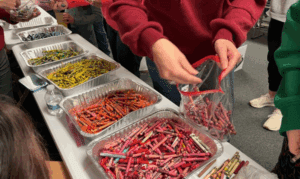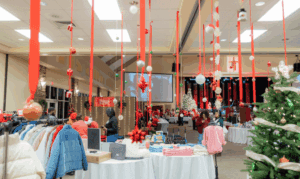I’ve written the following “tour” for some of the stained glass windows that frame our sanctuary at Prince of Peace Lutheran Church. You can see their pictures on our website www.princeofpeacefayette.org, or better yet, come worship with us to see them in person.
Let’s start with the Advent Windows. Our journey into the new Church Year begins with the artistic depiction of the Advent stained glass windows. Located at the rear of the nave, our entrance into the sanctuary is greeted by both windows, showing the strong trunked grapevine producing the branches, which grow into and through all the windows.
The left Advent window depicts the harvest time and the bounty of the growing season, which yields both the abundance of the fruit of the vine and the wheat of the field. These blessings give us the “elements” of the Lord’s Supper. The walking traveler is simply each of us on our own journey through “The Year” and through life. The autumn sky invites us to keep going on our adventure of faith.
The right Advent window shows Mary and Joseph on their specific journey to Bethlehem, which warmly awaits their arrival. Mary safely carries The Child inside her so that The King might have his rightful birthplace. The Angel of the Lord both protects and prepares for the glorious, yet humble, birth announcement.
Next are the Christmas windows. In both Christmas windows, the cold of winter forms beautiful icicles and suspended snowflakes that give witness to the chill of the earth at this time of year. But our hearts are warmed by the greatest gift of all, The gift of the Savior.
On the right, the little shepherd boy or girl, carrying the needy lamb against the cold, looks to the heavens to see the celestial light and hear the great Good News about the birth in the City of David of the Savior, who is Christ the Lord.
On the left, the humble birth in the cave is contrasted with the angelic pronouncement that this baby is The Savior, born to free all people from the curse of sin.
These windows accentuate the “rock of faith,” which is at the base of all the windows in one way or another.
We’ll move to The Pentecost windows. Fifty days after Passover the Jews celebrated Pentecost as a ceremonial day for first fruits offerings. It was however, on the first Pentecost after the Resurrection and Ascension of Jesus that the Holy Spirit came upon the disciples making them “The Church.” Now, of course, The Church celebrates The Day of Pentecost 50 days after Easter, marking the giving of the Holy Spirit.
The Season of Pentecost is the longest “Church Season,” stretching across the full second half of the year, while the first five seasons divide the first half. Pentecost is the “teaching season” of the church year, as the appointed Gospel texts for the Sundays recount His teachings, parables, and miracles.
Both Pentecost windows display the glow of brilliant candles, with flames reminiscent of the “tongues of fire” atop the disciples’ heads on that first Pentecost.
The three flames in the window on the left contain illustrations of three of Jesus’s parables which He used to teach about The Kingdom of God. The parables are The Sower and the Seeds, The Lost Sheep, and The Good Samaritan.
The three flames in the window on the right contain illustrations of three of Jesus’s miracles which He used as signs of The Kingdom of God. The miracles are The Feeding of the Five Thousand with five loaves and two fish, The Calming of the Storm, and the Healing of the Blind Man.
The blazing red flames and burning red background glass represent the fire of the Holy Spirit, which consumes us and sets us in motion to work for The Mission of Christ in the world.
The mature grapevine at the top of both of these windows bears the ripe and ready fruit, waiting only for the harvest and preparation for making the wine and bread for Holy Communion.
The Front Sacramental Window depicts the eternity of God and the Sacraments, which are the “means of grace” along with God’s Holy Word.
The Sacrament of Holy Baptism is represented by the many elongated shell-shaped pearl-white glass pieces. For many, a shell is commonly used to pour water over the head of those being baptized. It is in the water of our baptism where we are reborn children of our Heavenly Father and are made inheritors of eternal life.
The Sacrament of Holy Communion is represented by the stalks of golden grain that alternate with the shells that come from the center to the rim. From grain such as this, bread is made and consecrated as the Body of Christ in Holy Communion. The window is rimmed entirely with grapevines full of grapes, which will become the wine that is consecrated as the Blood of Christ in Holy Communion. It is in Holy Communion that we receive the Body and Blood of Christ for the forgiveness of our sins and the strengthening of our faith.
Find Kollmeyer at www.princeofpeacefayette.org











Leave a Comment
You must be logged in to post a comment.